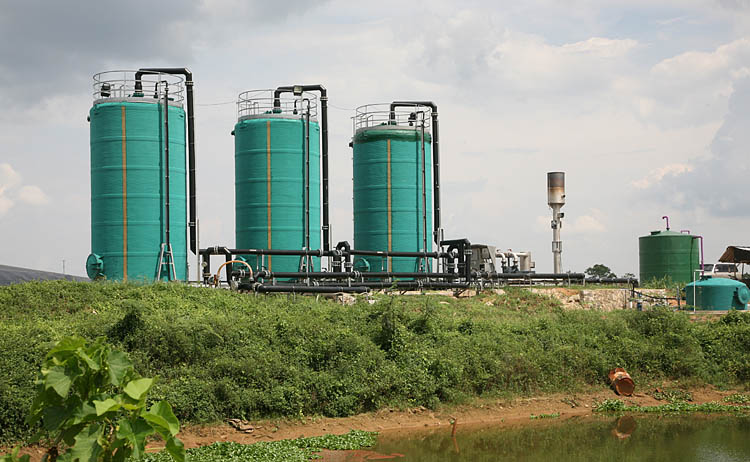Within wastewater treatment, the anaerobic digestion process emerges as a crucial remedy, providing numerous advantages for preserving the environment and generating energy. A comprehensive understanding of the complex processes involved in anaerobic digestion, specifically in sewage treatment, reveals a viable approach to effectively managing waste and developing renewable energy.
Understanding The Anaerobic Digestion Process in Wastewater Treatment
Anaerobic digestion is a naturally occurring biological process in different habitats, ranging from marshlands to industrial wastewater treatment plants. Anaerobic digestion is essential in wastewater treatment as it effectively decomposes intricate organic components found in sewage. Unlike aerobic digestion, which necessitates energy-intensive aeration devices to provide oxygen, anaerobic digestion functions in an environment lacking oxygen, making it more energy-efficient.
The anaerobic digestion process starts by introducing sewage sludge into a hermetically sealed reactor, providing an ideal environment for the proliferation of anaerobic bacteria. Methanogens are microorganisms that break down organic materials by carrying out a sequence of metabolic processes. At first, hydrolytic bacteria break down complex organic components, such as proteins, carbohydrates, and lipids, into smaller ones through hydrolysis. The acidogenic bacteria convert these less complex molecules into volatile fatty acids, acetate, hydrogen, and carbon dioxide through fermentation.
Acetate, hydrogen, and carbon dioxide are subsequently utilised as substrates by acetogenic bacteria, converting them into methane, carbon dioxide, and water. The primary components of this biogas are methane (CH4) and carbon dioxide (CO2), making it the principal output of anaerobic digestion and possessing substantial energy capacity.
The anaerobic digestion process is meticulously controlled to maximise biogas generation while assuring the effective breakdown of organic contaminants. Temperature, pH, retention time, and substrate composition are key factors that significantly influence the performance of anaerobic digesters.
Anaerobic digestion in wastewater treatment significantly benefits properly managing high-strength organic waste streams. Anaerobic digestion provides a sustainable method for transforming waste, such as sewage sludge from wastewater treatment plants or organic waste from food processing businesses, into energy and valuable by-products.
Furthermore, anaerobic digestion decreases the size of sewage sludge, simplifying and making managing and getting rid of the remaining solids more efficient and economical. This procedure also eradicates microorganisms in the sewage sludge, enhancing public health and safety.
Anaerobic digestion is a highly adaptable and eco-friendly method with significant potential for sustainable wastewater treatment. Using anaerobic bacteria, wastewater treatment facilities may effectively address environmental contamination while simultaneously producing renewable energy and valuable resources.
The Environmental Benefits of Converting Waste to Energy
Anaerobic digestion offers a compelling solution for environmental protection by converting organic waste into electricity. Wastewater treatment plants can diminish their carbon footprint and reliance on non-renewable energy sources by utilising biogas generated during digestion. In addition, anaerobic digestion helps to reduce the emission of methane, a highly potent greenhouse gas, into the environment.
How Anaerobic Digestion Transforms Wastewater into Biogas
The anaerobic digestion of sewage begins a revolutionary process, converting wastewater into a helpful resource. Under controlled conditions, organic matter decomposes, resulting in the production of biogas that is high in methane content. The biogas can be used as a renewable fuel for generating power and heating or as a fuel for vehicles, which helps promote the circular economy and sustainable energy practices.
Anaerobic Digestion of Sewage: Key Processes and Benefits
Sewage anaerobic digestion provides other advantages beyond the generation of electricity. This procedure efficiently treats wastewater, minimising the discharge of detrimental contaminants into the environment, thereby protecting water quality and human health. Furthermore, anaerobic digestion produces valuable by-products, such as nutrient-rich biosolids, that can be utilised as fertilisers, strengthening the environmentally favourable characteristics of this method for treating wastewater.
Anaerobic digestion is a crucial solution in wastewater treatment, providing a sustainable approach to waste management and energy production. Contact us now if you want to investigate how Organics can help develop customised anaerobic digestion solutions to meet your specific requirements. Let us join forces to pursue a path towards more environmentally friendly and effective methods of treating wastewater. Please reach out to us for more information today.

